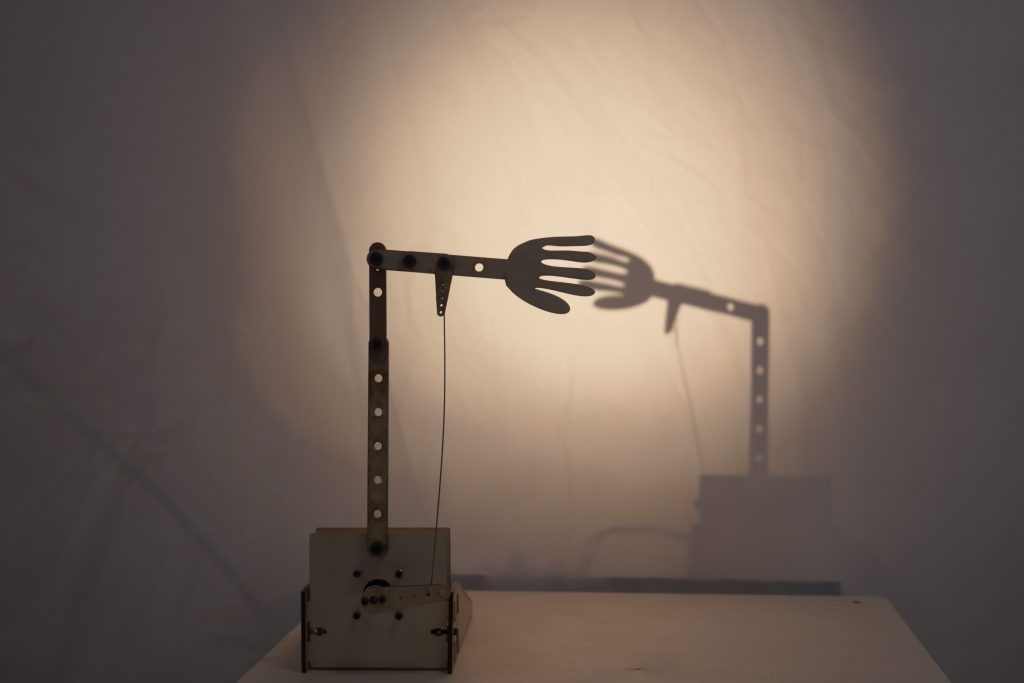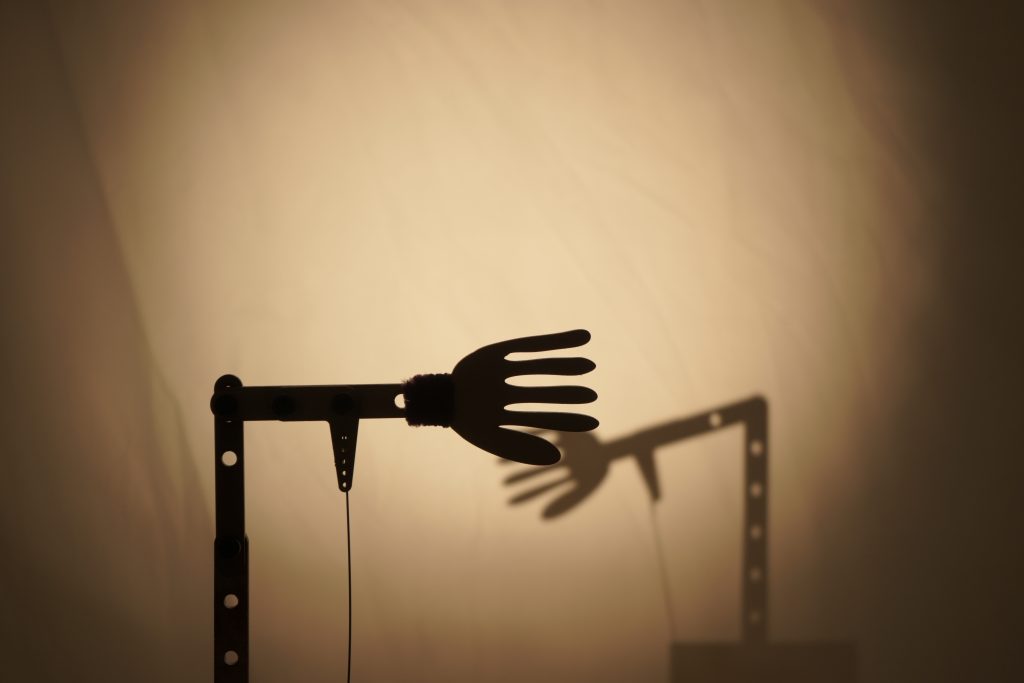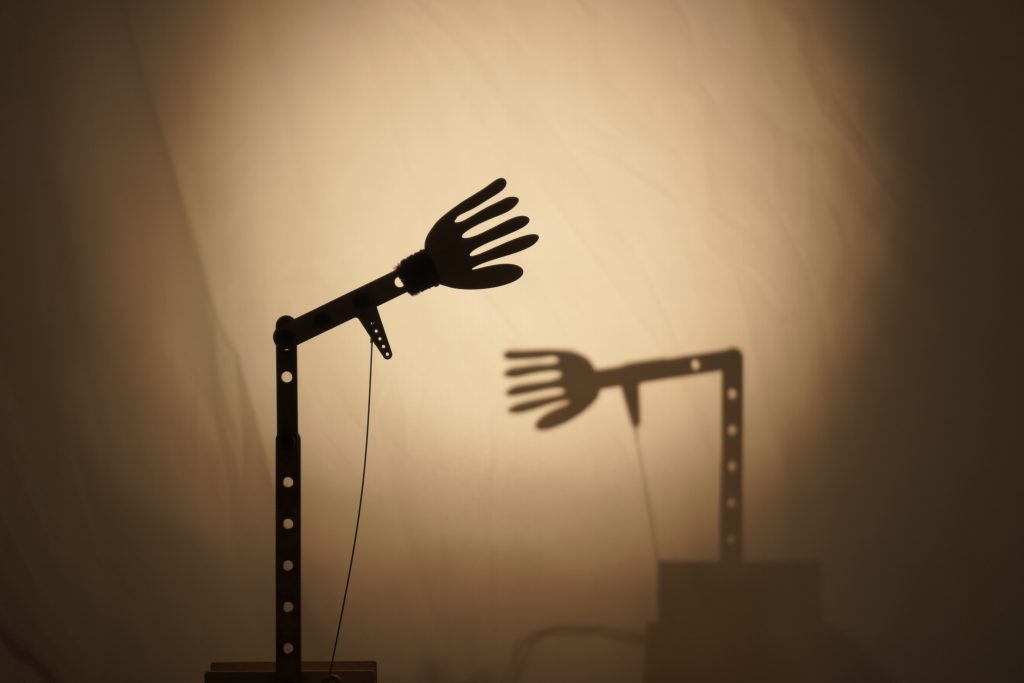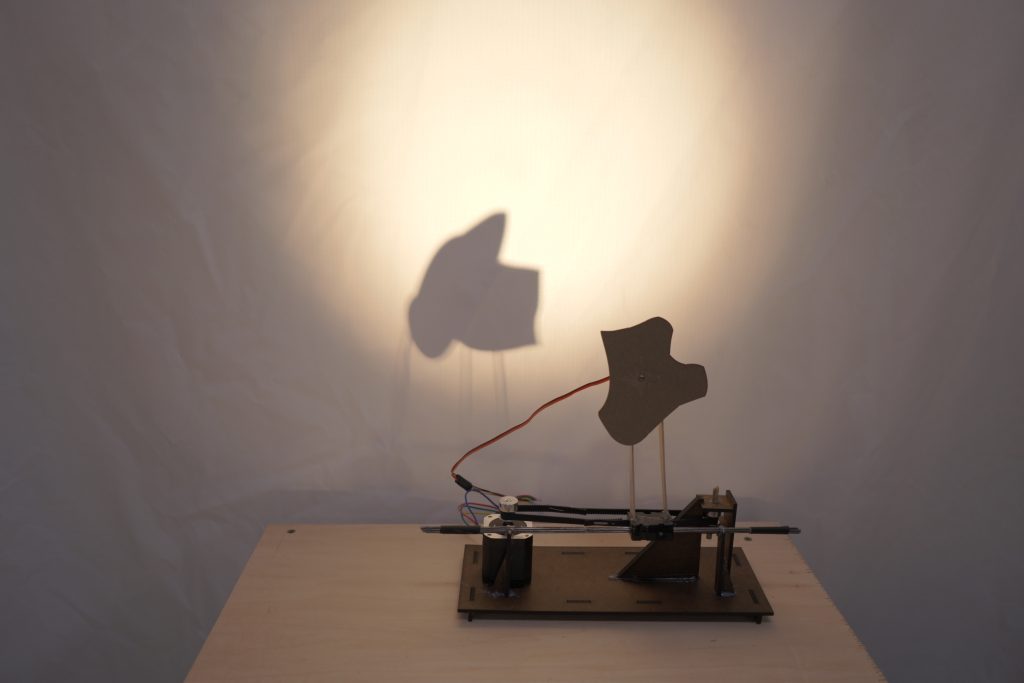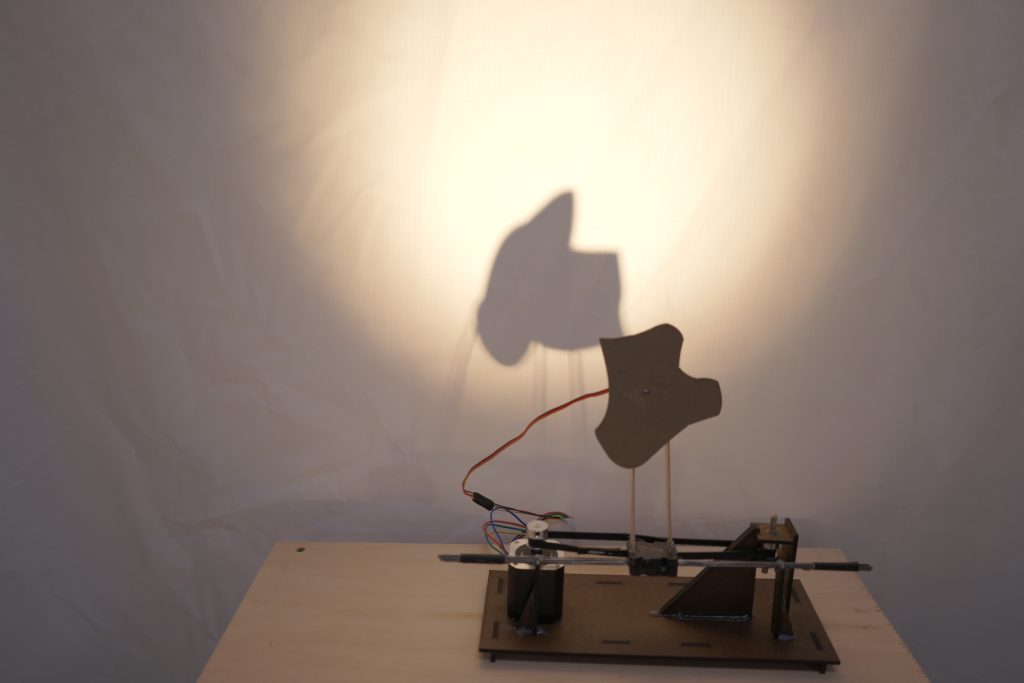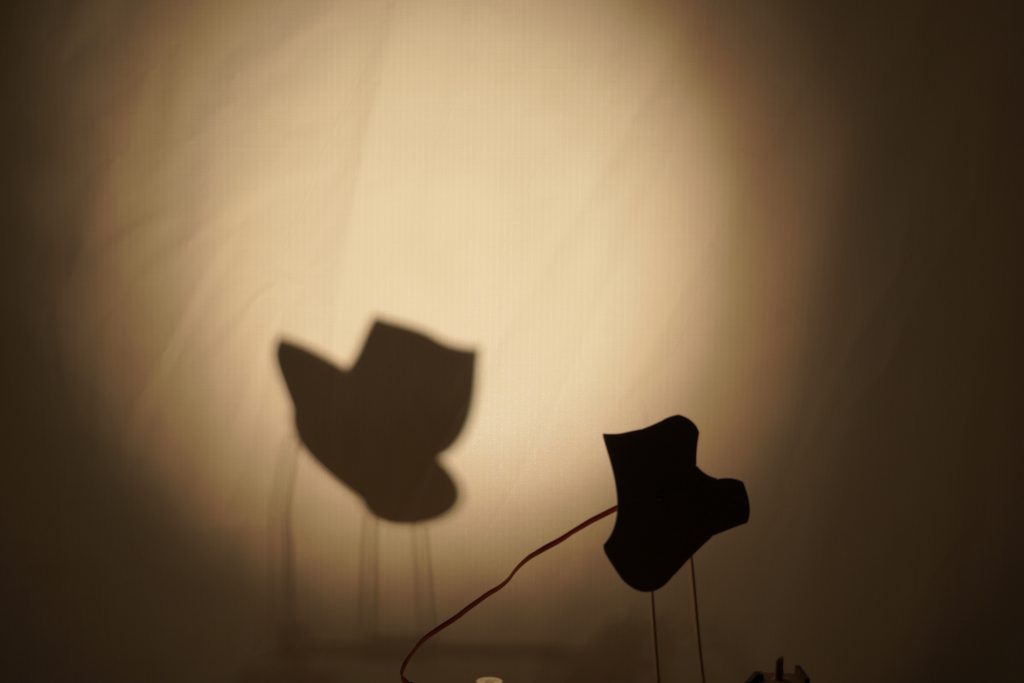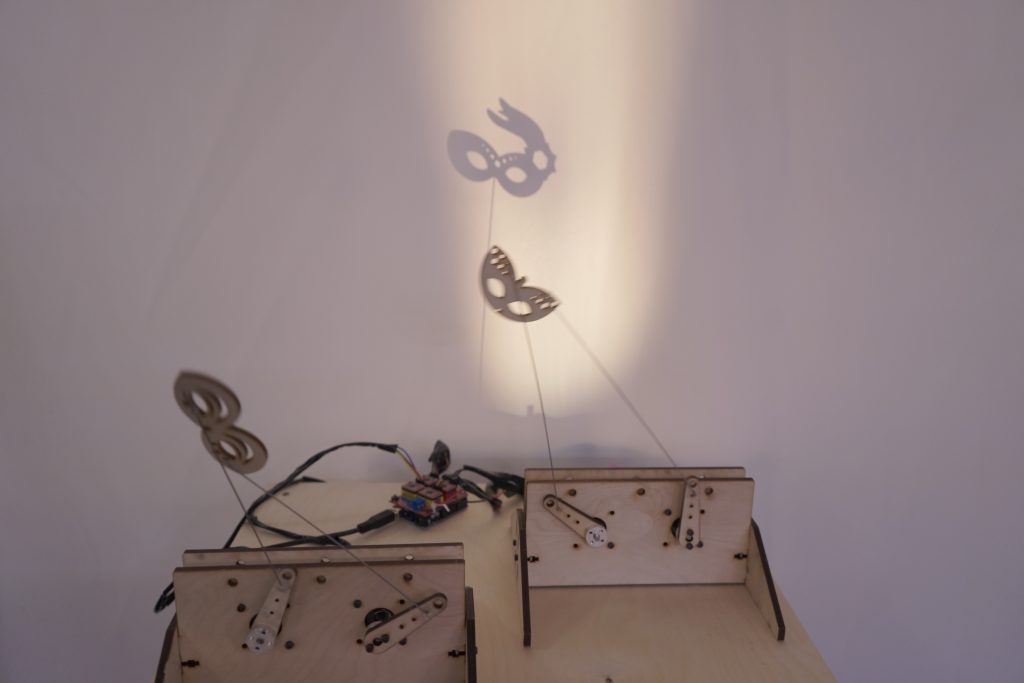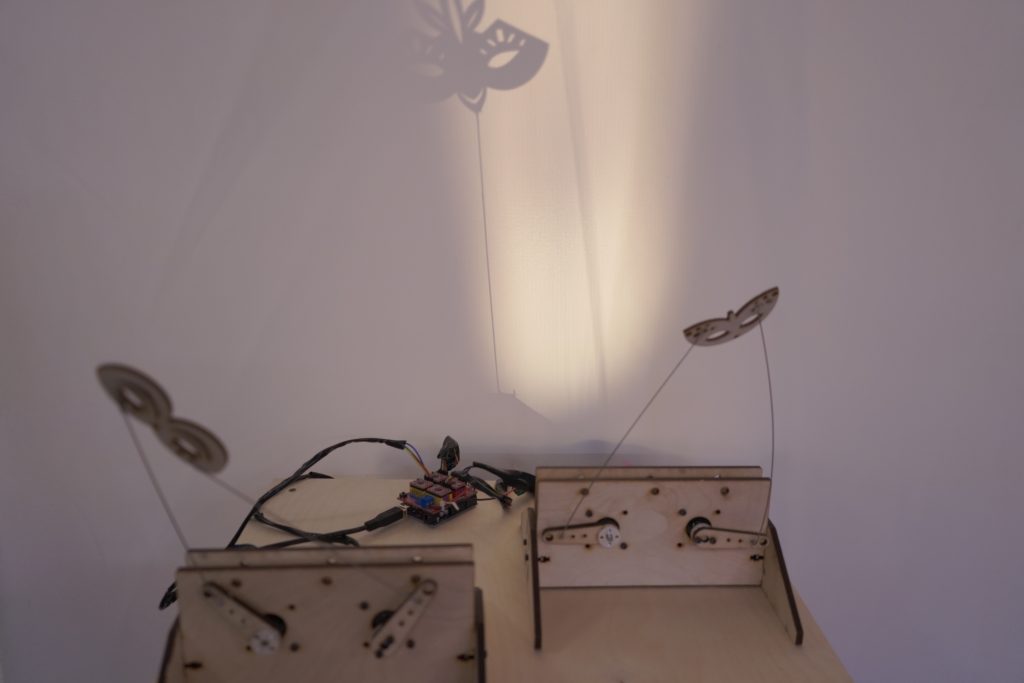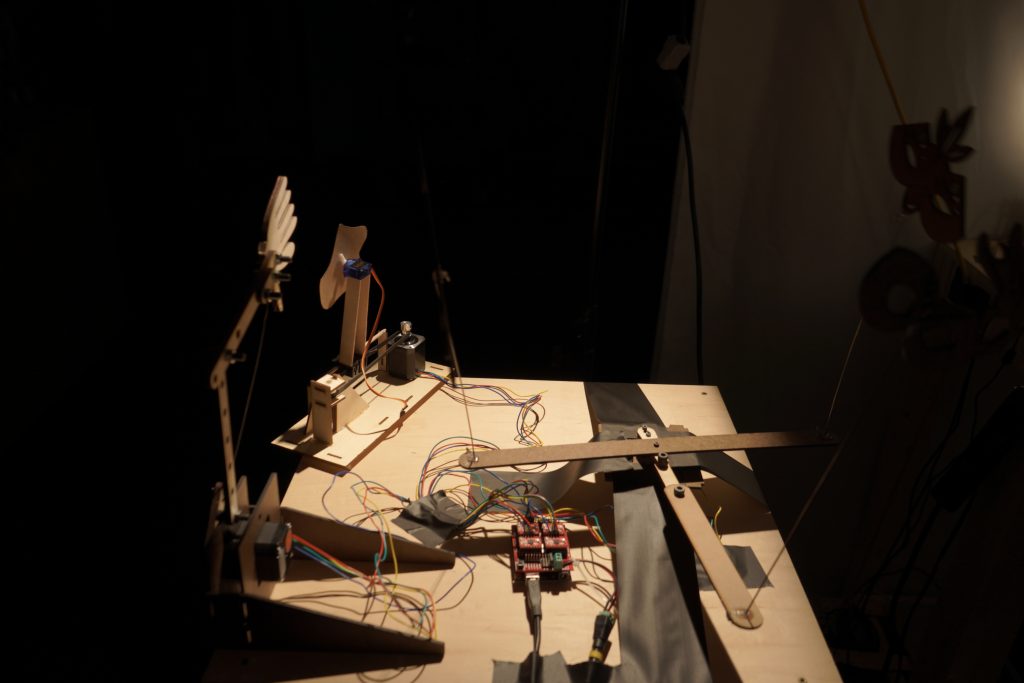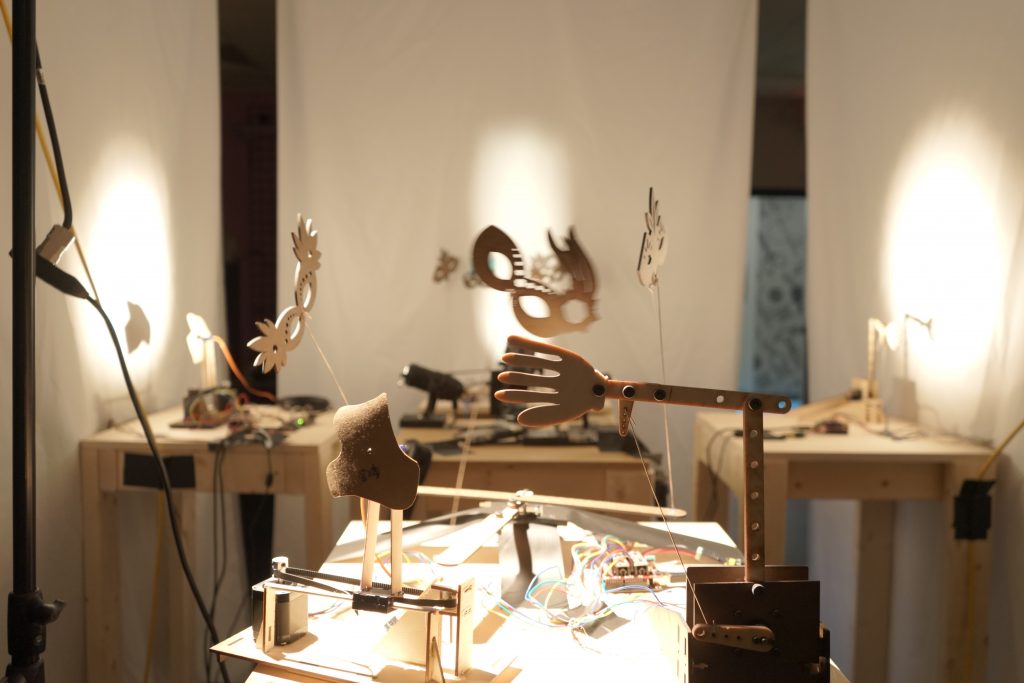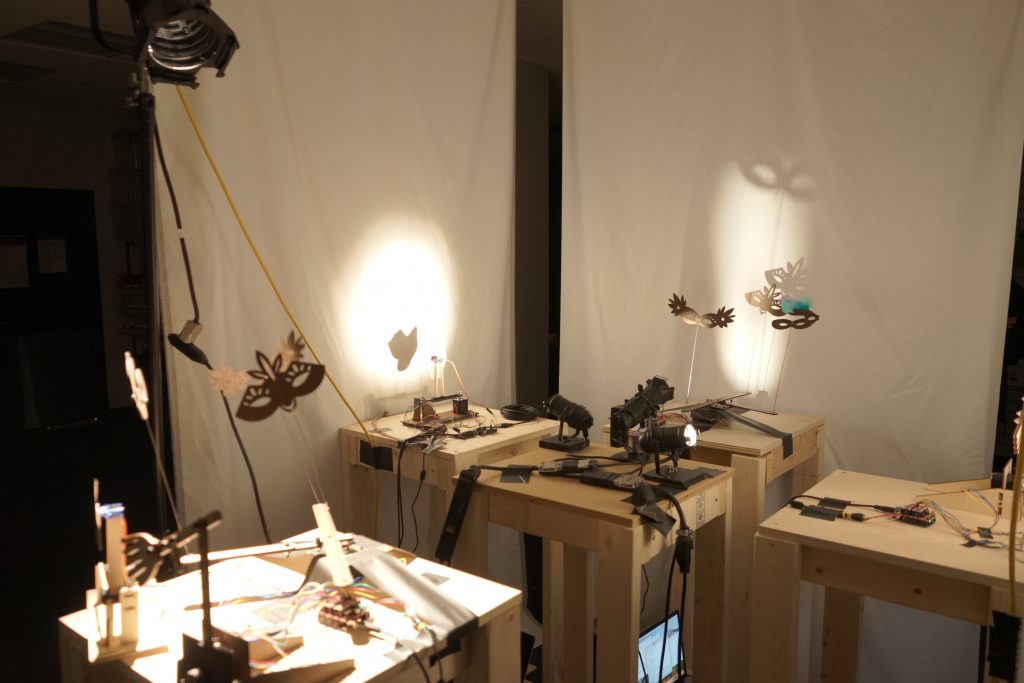This project began as an exploration of personifying robots. We thought of making this lamp that would both give and command attention from it’s viewers. Our robot stood in the middle and shined light on it’s performers until a viewer interrupted the show.
In terms of fabrication, we knew that our system of robots would be a conglomeration of lasercut and 3D printed parts. We began thinking of forms and characteristics each robot would take on. Originally we thought of expressions of emotions like laughter and fighting, from there we found our way to animals both conceptual and literal. These supporting robots eventually played roles in our garden, with our lamp standing in the middle. We repurposed robots from our past show in addition to creating new conceptual robots to take on personas that the lamp would be supervising.
As for production, we using motion capture to triangulate where users were so when they “interrupted” , the lamp would know where they were. This took on quite the technical challenge that drove the rest of our project. While we understood this was a risk, by the time the final show came around, the risk was extremely worth it. The point of this project was to create an interactive experience that intrigued and surprised users. The accuracy and reliability of the integration of motion capture and ROS led to great reactions from the audience. While this project implemented challenging tech and comewhat complex construction, it can’t necessarily be said that that was the focus of the performance. In fact, it could be said that the complex tech added another level of wonderment to the performance.
All in all, the team is satisfied with the result and excited about the opportunity to challenge ourselves. In addition to that the performance led to deeper more nuanced understanding of how tech can be integrated into art.
Roles
Tom: Programing the movement/light of the spotlight in ROS, processing motion capture in ROS, integrating animals with the Spotlight
Ben: Designing/building/assembling the Spotlight.
Avi: Programming and integration of animal robots with ROS
Abel: Programming and integration of animal robots with ROS
Elton: CADing and Laser Cutting the three animal robots. Motion Capture Set Up (Setting up network streaming, Moving Cameras, Calibrating), researching props, installation of props/robots
Sam: Assisted in design in Spotlight and animal robots. Final assembly and painting of spotlight parts
ZIP of the Animal Robot DXFs: https://drive.google.com/file/d/1nqYG1tPH75_7_2r2FtzmMv3LGiha8_5C/view?usp=sharing
Code:
https://github.com/Toms42/rcp_spotlight
zip file below:
CAD:
Zip-file below
https://drive.google.com/file/d/1uvq7704unAnncukpAVNLdFRt23_n9zOe/view?usp=sharing
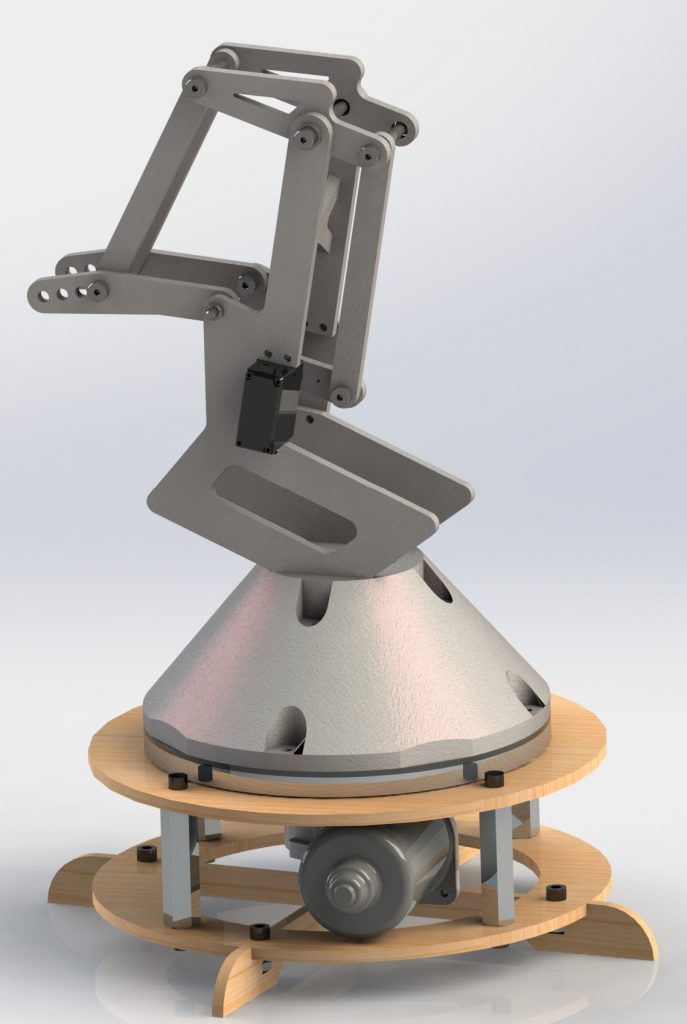
Statement:
Inspired by the experience of peer pressure, high standards and seemingly false perception of the outside world as young students, Facets is a shadow art installation that explores the concept of how people react and act differently according to social norms and standards under various situations. How does the persona we choose to put on under the influence of social standards relate to our own self? If we piece out ourselves segments by segments, where is the real, complicated and authentic self?
The installation consists of three mini robot “scenes” that describes the three major facets of a person, work, family, and social represented correspondingly by hand, puzzle and masks, as well as a composite robot that represents the whole person. While the shadow represents various personas people put on when interacting with different environments, the robots in front of the screens represent the real world, and they interact with each other to complete a unify scene for each situation. Displayed in a 360 degree setting, the audience are encouraged to explore each mini robots in the flow they want but reveal the composite as the last section of the installation for the audience to see how each scene relates to the composite robot.
Reflection:
The project really reminds us of the concept in acting where “emotions comes from motions”. The general set up of a piece could only suggest a limited amount of information and mood for the performance, and most of the emotions are communicated to the audience through carefully designed behaviors. Mood could spring from sets of conscious choices even though it seems to happen instantaneously during that moment. The movement in our project is more scripted and repetitive, yet it could still leave space for interpretation and trigger reflection and emotional reaction for the audience. Therefore, in future art practices, in addition to “training” the robots to behave and react with the surroundings with a given base foundation, artists and engineers could also focus on exploring the limits and possibilities of actions for machines. The boundary of robotics behavior is not limited by the foundational technology but the edge of design intention and imagination.
On the other hand, the spotlight group demonstrated another possibility of robotics performance. Personal characteristics could be added to still ordinary objects with the use of animated behaviors and creates a novel and unexpected experience for the audience. The interactive motion and the immersive environment adds more playfulness as well as audience presence to the entire experience. The twist of characters and dual motion allows the audience to become more aware of both their own and the robot’s actions, and gives the robot more autonomy as this challenges original thinking of robots as machines that acts upon humans’ requirements and needs.
Discussion:
The overall production was quite successful and we were able to execute most of our original intention. Due to the time limit, we stuck with the bare wood aesthetic for the overall production, with little details such as feathers and glitter added to the robots to show the differences between “facets of you” and “composite you”.
One of the main challenges that we faced was trying to balance the trio mask robot on the motor after we assembled it. We did not have time to design and engineer a base for the motor to balance out the robot so we had to solve the issue with black gafe tape, which looked a bit janky, but added a level of organic and imperfect quality to the piece per audience interpretation.
Another challenge we had was making some last minute adjustments to the install. The final presentation did not have enough space for the audience to look at the composite robot from right behind and due to limited lighting options, it was lit with a side light, which is a lot brighter and caused harsher shadows. However, the close proximity of the composite robot to the rest of the installation helped the audience to view them as one piece and draw connections with each scene.
In terms of robotic motion, we were able to program most of the motion we storyboarded for each scene. We carefully designed each scene so that they focused on one planar motion. The work scene had hands waving up and down; the family scene had puzzles rotating and tracking left and right; and the social scene had masks spinning in and out of the light. These choices was well executed and successfully conveyed our main original intention to the audience even with various detailed interpretation.
The only motion we were not able to program and see it for the final piece was trying to have the family scene robots stop and hold once they rotate and slide into their matching position to make the statement more obvious. There were also two matching positions and only one of them was obvious enough to the audience. The three dimensional linkage for the small dancing mask robot in front of the screen was a happy accident during production. The original intent was to have the masks dance and bounce in a more planar direction but with the way the piano wires were attached, they were a bit out of control and twisted a lot more. We left them the way they were as they added chaotic and drunk characteristics of those robots and it helped convey the mood of the scene.
Our biggest take away from this process was to embrace the changes and happy accidents in details that happen during production, while sticking onto the main idea and concept. There were several iterations of the piece when we storyboarded it, but once we had a workable solid idea we stuck with the format, while allowing small changes when putting the piece together in production. Additionally, for the purpose of installation with a clear emotion and storyline, we learned to make choices to help the audience focus on one effect at a time.
Production Contribution:
- All – storyboard, install
- Mingchi – “Family” and “Social” scene programming
- Sana – “Work” Scene design, fabrication and programming
- Jessica – “Family” Scene design, fabrication and programming
- Ying – “Social” Scene design and fabrication, production install and documentation
Footages are a bit raw but some segments are usable post production.
]]>“…we want the culprit to feel like a deer in the headlights…” It seems like this feeling you suggest could stem from a couple of origins, including:
- General discomfort with being a center of attention; fear of exposure.
- The surprise of discovering one has intruded into a space where one is an outsider and unwelcome.
- The ambiguity about power relationships with what are obviously machines: the discomfort of being accused of human supremacy; a discomfort with the idea of robots asserting authority.
- A general anxiety about being spurned or rejected by a clique.
A key distinction is whether the visitor ends up feeling highlighted because of what they did versus who they are. If I quietly walk into the space and it suddens becomes hostile, I may think it is simply because I am human and being ‘othered’ by the machines.
“The feeling we are trying to convey to the audience is one of respect for the robot’s show.” That seems more like a lesson than a feeling.
“We want the human viewers to feel like they are supposed to watch politely.” As-is, this is essentially your prompting of the interaction instructions.
These can both be deconstructed. The underlying feelings driving respect and politeness could be a sense of equality (i.e. the spotlight as peer); the desire to adhere to the social and class conventions of a theater (which may already apply by virtue of location); a fear of reprisal; a genuine pleasure in the show.
I’m guessing that communicating ‘frustration’ will be difficult, and likely seem comical; we are conditioned to our dominance over machines, it would take quite a bit of empathy-building for us to accept their frustration.
This makes me wonder how you can leverage the fear of the other visitors to your ends. If the other visitors can be induced to disapproval that would magnify the effect of the spotlight.
A perennial question with a robotic piece is the locus of agency. You’ve presented this as an autonomous intelligence, and that might be emphasized if there is a clear change of kinetic language between watching the show and glaring at the visitor. But this seems like something to remember as the form evolves since our preconceptions are likely to be that spotlights are wielded by humans.
Clarification questions
- Is the spotlight directing the performers, or simply following the flow of action from performer to performer?
- Are the performing robots actively trying to attract the attention of the spotlight, or simply putting on a show for their audience?
- Does the intended audience of the performers include the humans? Or is this a kind of robot one-on-one show (e.g. busking, or even robot lap dance)?
- What’s the content of the show? Is it in a visual language of robots for robots, or a kind of story-telling for anyone?
- Are the performers an ensemble, or separate sequential performances?
- How is the spotlight responding to the show apart from its attention? I.e., it is purely passive, or does it laugh and sigh along with the action?
- Does the robot show have an end, or is this a kind of eternal machine performance?
- What happens if the visitors are just very quiet and don’t move into the center? This is not altogether unlikely, given the ‘theater’ setting.
- At what point does the spotlight break its ‘eye contact’?
- Is the visitor solitary? If not, what happens if multiple humans are simultaneously active?
- Is the spotlight seem ‘of a kind’ with the performers? What’s the visual language of ‘performer’ versus ‘spectator’ here? Do they seem to come from the same place, or are they deliberately different?
Follow-ups
- The architecture of the space will have a lot of effect on the intended outcome; please now draw a floorplan to scale.
- Detailed technical inventory. You are competing with the other group for existing hardware, we need a solid reckoning of what we need to build or buy.
The set up of the performance consists of four projection surfaces and four lights that symbols the idea of society, as well as four robots, with the same form but varying in decorations and colors, that represents human beings. Each robot is isolated within their own quadrant and the shadows projected on the screen is the only connection they have with each other. Seeing the shadows, one would follow and react towards the other, which will then create a synced chain reaction where all four performs the same motion. As we would like the audience to focus on the actions and emotions of the performance, we would like to keep the robot component simple by using the existing two link arms and stepper motors set-up.
We would like to start the performance with a simple and friendly action such as the hand wave to provide a fun and relaxing set up. However, when the intensity of the light source increases, and the robots see the shadows of others clearer, each of them would start acting more and more aggressively with the same action, waving faster and more rigid, until they break themselves. Since each of the robot will also have different tolerance level of “stress”, they will gradually reach the final action one by one.
The feeling we are trying to convey to the audience is one of respect for the robot’s show. We want the human viewers to feel like they are supposed to watch politely, but then if a human moves too fast or makes too much noise the spotlight will whip around to face them. The performing robots will also stop, and we want the culprit to feel like a deer in the headlights. Hopefully everyone’s attention has shifted to them, and robots will all be making it clear that they’re upset.
A big question with all of this is if humans will feel bad for interrupting or affecting the robot’s show. Will the cause of their embarrassment be the robots clear frustration or the light on them that causes them to become the center of attention?
Our spotlight will be a pixar-esque lamp that is quite bright. It will have added motor and joint components necessary to enable it’s robotic control. The classic lamp turned cyborg will hopefully convey the importance of where it is looking, without making it seem too dominant over the performing robots. The performing robots will likely be dressed up versions of the robots we used or our performance halfway through the semester. The dressing will give the robots less of a fragile wood feel.
-Ben, Sam, Tom, Avi, Abel, and Elton
Artistically, I think it would be hard to convey to the user that I want the focus to be on them, as well as the idea that they are ‘in’ the scene. Technically, it might be difficult to make that many moving parts, even if they’re isolated.
Main steps are as follows:
- Build individual motions
- Arrange into a ‘path’ that the user can walk through
- Arrange lighting such that it conveys the user’s centrality to the piece
I also don’t know if this idea might be as feasible because it’s harder to send in one person at a time. Maybe that might make it not as practical, though in an ideal world that would be how I would do it.
]]>The possible artistic difficulty will be if the audience can get the idea that the robot is dancing with the shadow. Another question is that is it going to be a typical robot dance which is rigid, stiff, or is it going to be a smooth flow. The technical difficulty will be how to drive the motor such that it implements the movements.
The crucial steps are listed as follows:
1) Test the light, with different wooden pieces, and generate different size of the shadow, by moving closer or farther to the light. Choose an appropriate distance.
2) Come up with a theme of the dance or decide to be an improvisation.
3) Decides the shape of the robots.
4) Choreograph (‘code’).
5) Decorate so that the shape of the shadow can be even more dramatic.
My concern with the visual element of this piece would be how to distinguish the abnormal robot. Because of the layout in a circular/square format, not all of the robots will be visible to the audience at any one time. I would be concerned that the meaning behind the piece would not be conveyed if an audience member just happened to never see the leading robot, and therefore how the changes/reactions in interactions are generated.
To test this proposal, in the interest of time and efficiency, I would use all four of the robots that we currently have and arrange them in the layout described in Ying’s proposal. Using this approach, we’d be able to quickly prototype the general layout and lighting. We may find configurations or sizing constraints that would be better-suited to this particular exhibit, which could inform the design of new robots specifically for this proposal.
After designing new robots based on what we learned in prototyping the layout, we can start to program what the interactions would look like. In the beginning, I think that the robot should be clearly interacting with the shadow to signal that each entity is seen as its own character in that specific section. After that is demonstrated, I think it would then be appropriate to program more coordinated behaviors among the robots.
I think the most difficult technical element would be the coordination and tuning of the timing between the robots to convey a sense of unity and interaction. A potential solution to this would be to just prototype some times/sequences between only two robots and then apply what we learned from that to the entire exhibit.
]]>